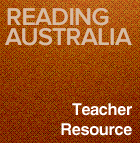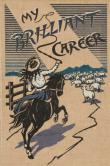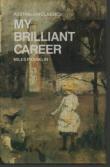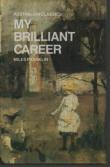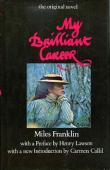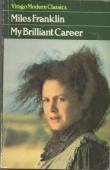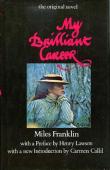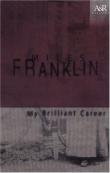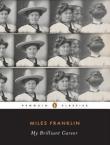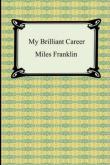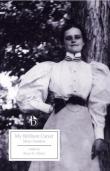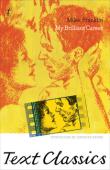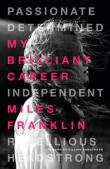AustLit
Latest Issues
AbstractHistoryArchive Description
'My Brilliant Career was written by Stella Franklin (1879-1954) when she was just nineteen years old. The novel struggled to find an Australian publisher, but was published in London and Edinburgh in 1901 after receiving an endorsement from Henry Lawson. Although Franklin wrote under the pseudonym 'Miles Franklin', Lawson’s preface makes it clear that Franklin is, as Lawson puts it 'a girl.'
'The novel relates the story of Sybylla Melvyn, a strong-willed young woman of the 1890s growing up in the Goulburn area of New South Wales and longing to be a writer.' (Publication summary)
Adaptations
-
form
y
 My Brilliant Career
( dir. Gillian Armstrong
)
Adelaide
:
Margaret Fink Productions
,
1979
Z817179
1979
single work
film/TV
(taught in 7 units)
My Brilliant Career
( dir. Gillian Armstrong
)
Adelaide
:
Margaret Fink Productions
,
1979
Z817179
1979
single work
film/TV
(taught in 7 units)
Based on the book by Miles Franklin, this feature film tells the story of an Australian country girl who, at the end of the nineteenth century, wants to make her own way in the outside world.
Rejecting an offer of marriage from a wealthy suitor (who is also her childhood friend), she instead finds herself obligated to work off her father's debt to a neighbouring family, for whom she works as governess and housekeeper. Returning home, she again rejects her suitor's proposal, this time in favour of writing a novel based on her experiences.
-
My Brilliant Career
2020
single work
drama
'Australia, on the cusp of a new century. Sybylla Melvyn has grown up beyond the black stump, but she is determined to get away and make her own spectacular mark on the world. But if that’s to happen, she must first surmount collapsing family fortunes, a world hardwired against headstrong women, and the insistent nagging of love.'
Source: Publisher's blurb.
-
My Brilliant Career
2021
single work
drama
'Sybylla Melvyn is a young woman on the verge of life and freedom and is determined, above all else, to break down the barriers keeping her from both.
'From the award-winning Skin of Our Teeth Productions comes My Brilliant Career, a theatrical re-imagining of Stella Miles Franklin’s timeless novel. This is the story of Sybylla Melvyn, a young woman on the verge of everything – hope, loss, freedom and the search for independence. Christine Davey’s adaptation is a glorious love letter to landscape and language, a homage to life.'
Source: La Mama Theatre.
Reading Australia
This work has Reading Australia teaching resources.
Unit Suitable For
AC: Year 12 (Literature Unit 3)
Themes
adaptation of novel to film, Australia, Australian country life, film study, gender, love, narrative voice, setting, social reading, structure, women
General Capabilities
Critical and creative thinking, Information and communication technology, Intercultural understanding
Notes
-
My Career Goes Bung is the sequel to My Brilliant Career.
Contents
- My Brilliant Career : Introduction, single work criticism
Publication Details of Only Known VersionEarliest 2 Known Versions of
Other Formats
- Sound recording.
- Braille.
- Large print.
Works about this Work
-
Guide to the Classics : My Brilliant Career and Its Uncompromising Message for Girls Today
2020
single work
column
— Appears in: The Conversation , 10 December 2020;'Growing up in Australia in the 1970s, I much preferred the hijinks of Han Solo and Chewie to Princess Leia’s sexualised damsel in distress. My sister and I spent an entire summer pigging out on Choc Wedges and Barney Bananas so we could collect the men’s cricket team on specially marked sticks. Feminism seemed a world “far, far away”. Yet what Australian girls could and couldn’t do was being explored through a glut of screen adaptations of classic novels.' (Introduction)
-
Bold Women in Print
2017
single work
criticism
— Appears in: Unbound : The National Library of Australia Magazine , September 2017;'Curator Grace Blakeley-Carroll looks at early twentieth-century Australian female writers and the publishing industry.'
-
Going To The Silences
2017
single work
essay
— Appears in: Sydney Review of Books , June 2017;'A long time ago, after the publicity had finished for my first memoir When It Rains and while I was still brimming with writing confidence and no real direction I dreamed what my next book was to be. Woken by a willie wagtail calling outside my window I reached for the notebook on the bedside table. With eyes still sticky with sleep I scrawled down the details of the extraordinary walk I had just taken with Miles Franklin.' (Introduction)
-
Toward Worlding Settler Texts : Tracking the Uses of Miles Franklin’s My Brilliant Career through the Curriculum
2017
single work
criticism
— Appears in: Australian Literary Studies , September vol. 32 no. 2 2017;'Using Miles Franklin’s My Brilliant Career as its focus, this paper explores the institutional possibilities and constraints of ‘worlding’ settler texts in secondary school and university environments. We argue that the teaching of texts, and those who teach texts in schools and universities, play a key role in negotiating national and international textual boundaries. This paper expands on the practices of reading, to incorporate an analysis of documents that frame the intended, espoused, and enacted curriculum. Examining the publication and teaching history of My Brilliant Career in Australia and overseas and the use of literature as a tool of nationalism and globalisation, this paper argues that the teaching of literature in institutions acts as material evidence of our efforts to negotiate the demands of the national and the global. Literature teaching thus powerfully contributes to the ways in which we understand the work that is undertaken, the boundaries crossed and compromises brokered when we study settler texts in globalised contexts.' (Publication abstract)
-
Hero and Tragedy : An Analysis of Sybylla Melvyn in My Brilliant Career
2016
single work
criticism
— Appears in: 澳大利亚文化研究 , June vol. 1 no. 2 2016; (p. 45-57)'My Brilliant Career, published in 1901, is the first and also the most influential work of Australian writer Miles Franklin (1879—1954). It depicts a “new woman image” which represents an ambitious, imaginative, rebellious bush girl and genuinely reflects the late 19th century Australia. She rebels and fights but fails to get out of the colonial women’s miserable life without any patriarchal persecution. She is reproached and excluded by public. She is left lonely and helpless and is nearly on her breakdown. She is a brave warrior of feminism, but still another tragic character of patriarchy.'
Source: Abstract.
-
Untitled
1930
single work
review
— Appears in: The North Queensland Register , 21 June 1930; (p. 35)
— Review of My Brilliant Career 1901 single work novel ; Ten Creeks Run : A Tale of the Horse and Cattle Stations of the Murrumbidgee 1930 single work novel -
Untitled
2012
single work
review
— Appears in: The Lifted Brow , no. 14 2012; (p. 28)
— Review of My Brilliant Career 1901 single work novel -
Untitled
1966
single work
review
— Appears in: The Canberra Times , 26 March 1966; (p. 13)
— Review of My Brilliant Career 1901 single work novel ; Bush Studies 1902 selected work short story -
The Backward Glance
1966
single work
review
— Appears in: Australian Book Review , May vol. 5 no. 7 1966; (p. 134-135)
— Review of My Brilliant Career 1901 single work novel ; The Pea Pickers 1942 single work novel ; The Long Prospect 1958 single work novel ; Bush Studies 1902 selected work short story -
Untitled
1966
single work
review
— Appears in: The Australian , 7 May 1966; (p. 9)
— Review of My Brilliant Career 1901 single work novel ; Literary Australia 1966 anthology criticism ; Bush Studies 1902 selected work short story -
The New Woman in the New World : Evelyn Dickinson and a New Type of Australian Heroine
2001
single work
criticism
— Appears in: Australian Studies , Summer vol. 16 no. 1 2001; (p. 1-21) -
Miles Franklin: The Outside Track
1988
single work
criticism
— Appears in: Multiple Worlds, Multiple Words : Essays in Honour of Irene Simon 1988; (p. 239-256) Breaking Circles 1991; (p. 118-143) -
The Olive Schreiner of Australian Literature
1932
single work
criticism
— Appears in: Illustrated Tasmanian Mail , 16 June 1932; Nettie Palmer : Her Private Journal Fourteen Years, Poems, Reviews and Literary Essays 1988; (p. 419-422) -
A Comet of Wonder Fallen to Earth: The Diaries of Miles Franklin
2003
single work
criticism
— Appears in: Australian Book Review , October no. 255 2003; (p. 35-40) -
Images of Woman in Miles Franklin's My Brilliant Career and Alice Munro's Who Do You Think You Are?
1994-1995
single work
criticism
— Appears in: The Commonwealth Review , vol. 6 no. 2 1994-1995; (p. 79-84)
- Monaro, Cooma area, Cooma - Snowy - Bombala area, Southeastern NSW, New South Wales,
- Goulburn, Goulburn area, Southern Highlands - Southern Tablelands, Southeastern NSW, New South Wales,
- Goulburn, Goulburn area, Southern Highlands - Southern Tablelands, Southeastern NSW, New South Wales,
- 1890s


